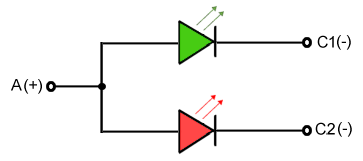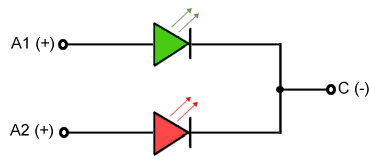Typical designs of multi-color LEDs
There are generally two types of LEDs, monochrome and multicolor. With monochrome LEDs, it is possible to adjust the brightness via the current in the forward direction, but the color is unchangeable as the LED is made of only one semiconducting material and therefore emits a specific wavelength. The color of the LED is not affected by the control mode. With the multi-colored LEDs, there are different types with different color options. An n-color LED consists of n individual semiconductor PN transitions combined in one housing. The individual LEDs in the multi-color LED consist of the corresponding semiconducting material, which emits the corresponding wavelength. The types RGB (red-green-blue), RGBW (red-green-blue-white) and RGBWW (red-green-blue-white-white) are common. The exact color emitted is determined by the current through the individual semiconductor transitions.
Monochrome LEDs differ in their semiconducting material, resulting in different characteristic values and colors.
The characteristic values and colors also differ with multi-color LEDs. In the case of multi-color LEDs, however, it is additionally necessary to consider how the individual monochrome LEDs are interconnected within the multi-color LED light source. Some of the possible interconnections are illustrated and explained below:
1. Inverse parallel
The “Inverse parallel” interconnection only works with two (differently colored) LEDs. With this interconnection it is possible to create different color mixtures with two LEDs.
 Fig.17: Inverse parallel LEDs
Fig.17: Inverse parallel LEDsWhen the current flows from A to B, a green light is output because the green LED is operated in the forward direction. From B to A, the red LED would light up. Since the different colors have different conducting voltages, each LED requires its own series resistor or current controller. With bidirectional current, the two LEDs would light up alternately. If the current direction changes with a significantly shorter period than the exposure time of a camera, the individual colors of the LED mix to a mixed color. To the human eye, the colors also appear mixed in the case of a quick change.
This type of arrangement of two LEDs is used, for example, to indicate polarity, e.g. for the correct connection of batteries or power supplies.
2. Common anode
The “common anode” interconnection can be used to combine any number of LEDs. This method is common with many RGB/RGBW LEDs. In addition to switching the individual LEDs on and off, only a low current may flow through some of them. This makes any color mixture possible.
All LEDs have a common positive potential at the anode (+). In order to operate an LED in the forward direction, a lower potential must be applied to the cathode connection of the desired color than to the anode connection. If the potential at the cathode (-) is higher, the LED is operated in the reverse direction. Caution: LEDs often have very low reverse voltages of only a few volts!
 Fig.18: Common anode LEDs
Fig.18: Common anode LEDs3. Common cathode
The operation of LEDs with a common cathode (-) is similar to that with a common anode (see “Common anode”). This method is used less often than common anode. Here, too, any number of LEDs can be combined in different colors. Any color can be generated by switching the LEDs on and off differently.
With the “common cathode” interconnection, all LEDs have a common negative potential. In order to switch on an LED, a higher potential must be applied to its anode (+) than to the cathode (-).
 Fig.19: Common cathode LEDs
Fig.19: Common cathode LEDs